Samsung S95F review: the most tantalising TV of the year
The pinnacle of OLED technology, Samsung's S95F is super-bright, yet beautifully controlled, and features an anti-glare panel that looks stunning in all conditions

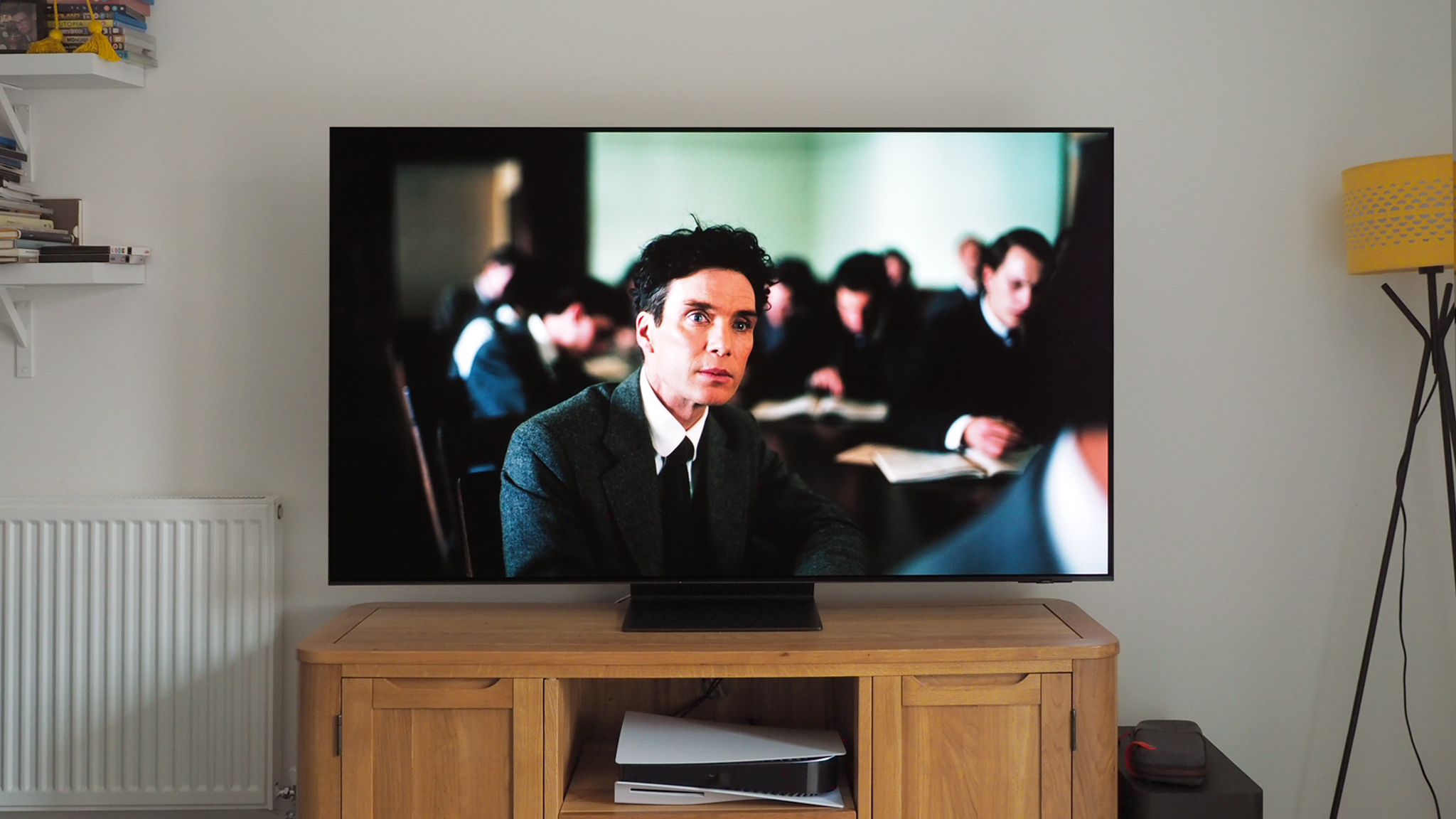

If you're willing to pay for best-of-best and want a gaming and home-cinema powerhouse, look no further. The Samsung S95F delivers pure class thanks to picture modes that rival classic OLED with great nuance to their black levels. Let the unrivalled brightness levels loose, however, and for gaming sessions and other dynamic content, the punch from its images has serious clout. Sure, there's no Dolby Vision HDR, and the AI mode can be heavy-handed. But now I've lived with the S95F as my own, I feel it's the perfect blend of design elegance, deft picture control, and admirable sound output. It's an untouchable all-rounder.
-
+
Super-bright QD-OLED panel delivers beautiful image quality
-
+
All HDMI ports are 2.1 type (to 165Hz), so it's great for gamers
-
+
Anti-glare panel ideal for all lighting conditions
-
+
Sounds surprisingly great too
-
-
It's a Samsung, so forget about Dolby Vision for HDR
-
-
Strong competition from LG OLED G5 and more
-
-
AI can get carried away with auto-adjustment
Why you can trust T3
Just a couple of years ago, it looked as though we were at the precipice of what the best TV technology could offer. Yet, here we are in 2025, and tellies such as this, the Samsung S95F, are here to rip up the rule book once more.
Samsung's flagship for the year features the latest-gen QD-OLED panel type, which is not only brighter than its S95D predecessor's, it also upgrades the anti-glare panel's finish – so it's perfect in daylight or darkness. Compared to the best classic OLED TVs, the S95F has some fancy extra tricks.
That's not to say there's a lack of competition, though. LG, for example, has been hard at work in research and development, deploying its new multi-layer OLED panel type in the OLED G5 (doing away with its previous pinnacle technology, Micro Lens Array (or MLA), in the process).
Impressive as that is, however, the Samsung S95F's delivery is simply stunning across the board – and the brightest I've ever seen. From the moment I first turned this set on, to having lived with it for a week of eye-melting gaming, streaming and movie-watching, it's given me 'TV of the year' vibes on a daily basis.
How much does the S95F cost?
Being at the top-end of the TV spectrum, the S95F doesn't come cheap, but it is competitively priced against its 2025 competition. I've had the 65-inch version in for testing, which is priced at £3,399 / $3,299 / AU$5,299.
| Header Cell - Column 0 | UK £ GBP | US $ USD | AU $ AUD | Header Cell - Column 4 |
|---|---|---|---|---|
55-inch | £2,499 | $2,299 | AU$3,999 | Row 0 - Cell 4 |
65-inch | £3,399 | $3,299 | AU$5,299 | Row 1 - Cell 4 |
77-inch | £4,499 | $4,499 | AU$7,999 | Row 2 - Cell 4 |
83-inch | £6,999 | $6,499 | AU$9,999 | Row 3 - Cell 4 |
The S95F is also available in 55- and 77-inch sizes – with day-one pricing outlined in the table above – featuring that same QD-OLED panel type; there's an even larger 83-inch model, too, but this ditches QD-OLED panel – and shouldn't be considered as the same.
S95F vs S95D: What's New?
- Second-gen QD-OLED panel type is brightest yet
- New 'Glare Free' panel coating upgrade
- The latest NQ4 AI Gen3 processor
- Samsung Vision AI automation
- One Connect box, for all ports
- 4x HDMI 2.1, to 165Hz refresh
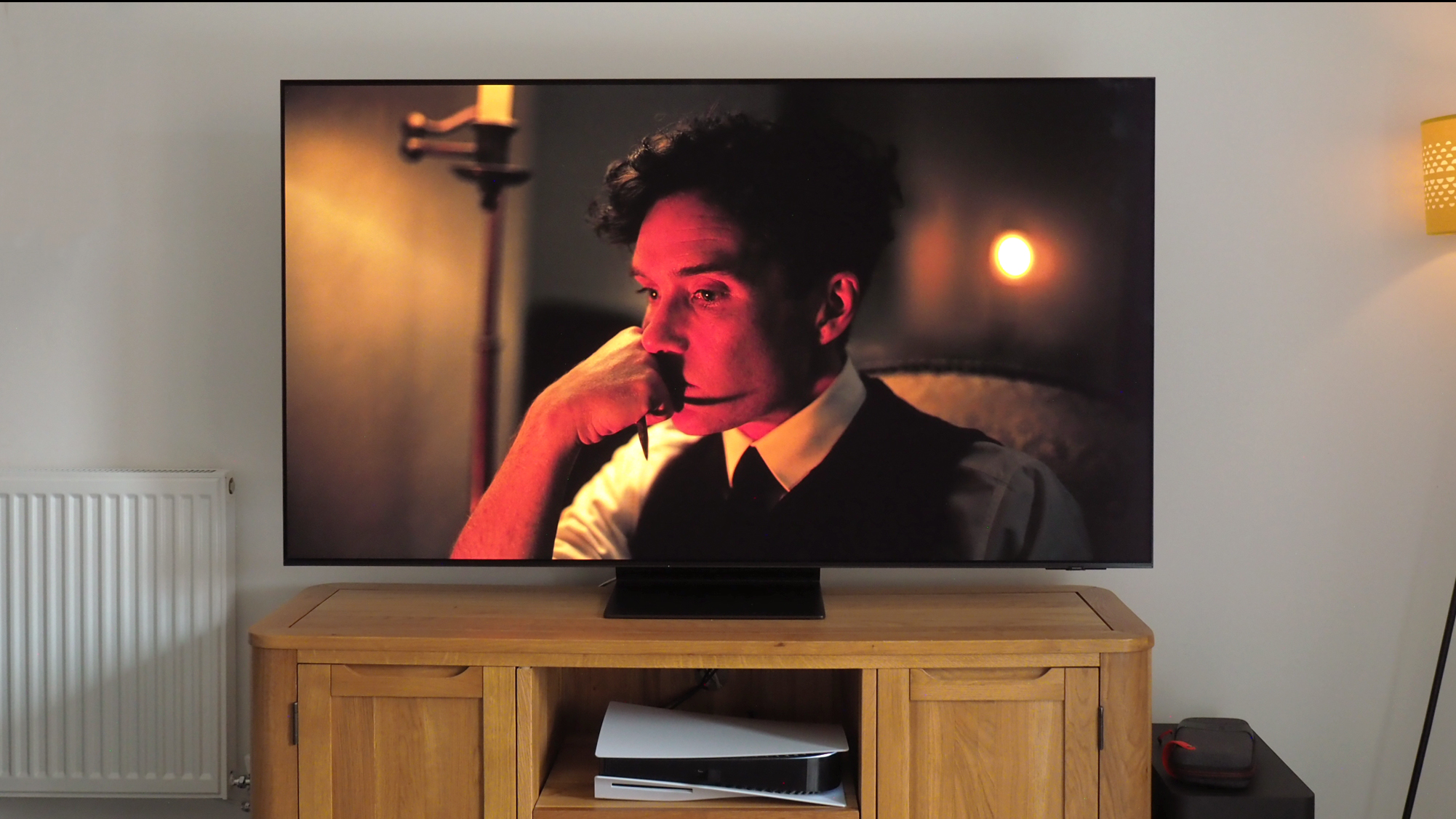
Unboxing the S95F was unlike any other recent TV assembly I've performed – because it's such a thin panel, at 11mm, you can feel it almost flex. Certainly a two-person job, then, not that it's as heavy as many other sets.
Get all the latest news, reviews, deals and buying guides on gorgeous tech, home and active products from the T3 experts
That's down to the One Connect Box, a separate unit which takes all the ports (including mains power) away from the TV's body, hence enabling such a slender frame. This separate box design, which Samsung only features on its flagship sets, makes the S95F great for wall-mounting, as you can hide the box away elsewhere for easy access with only a single cable headed into the telly itself.
That design isn't unusual for some high-end Samsung sets, as I say, but I do think it's quite brilliant. It doesn't compromise anything either, as all four of the HDMI ports here are the HDMI 2.1 standard, with passthrough at (well, actually beyond) the desired 120Hz that gamers and future-proofers pine for. Here, all four can squeeze up to 165Hz for relevant sources, but little other than mega PC rigs can deliver that right now.

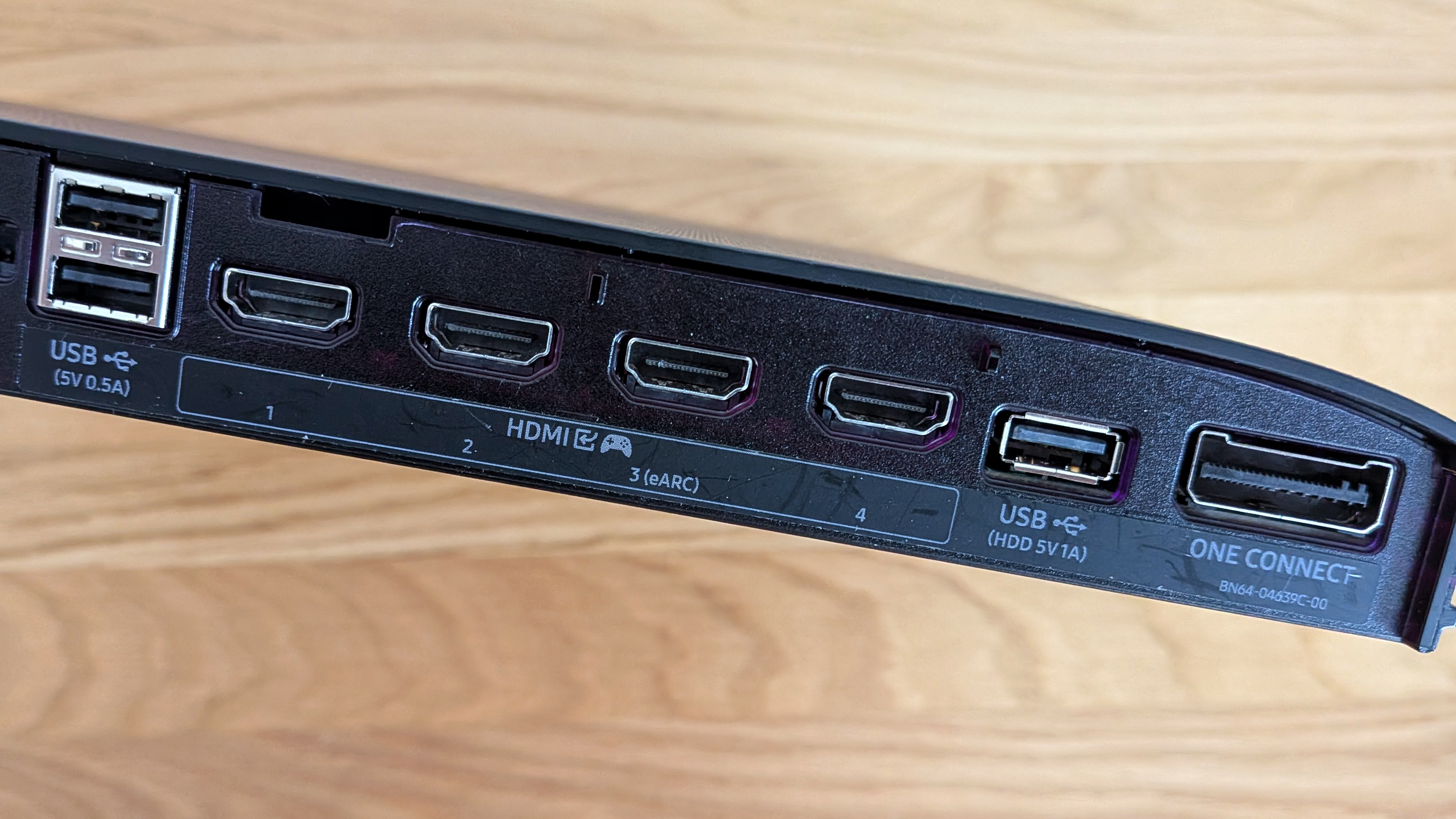
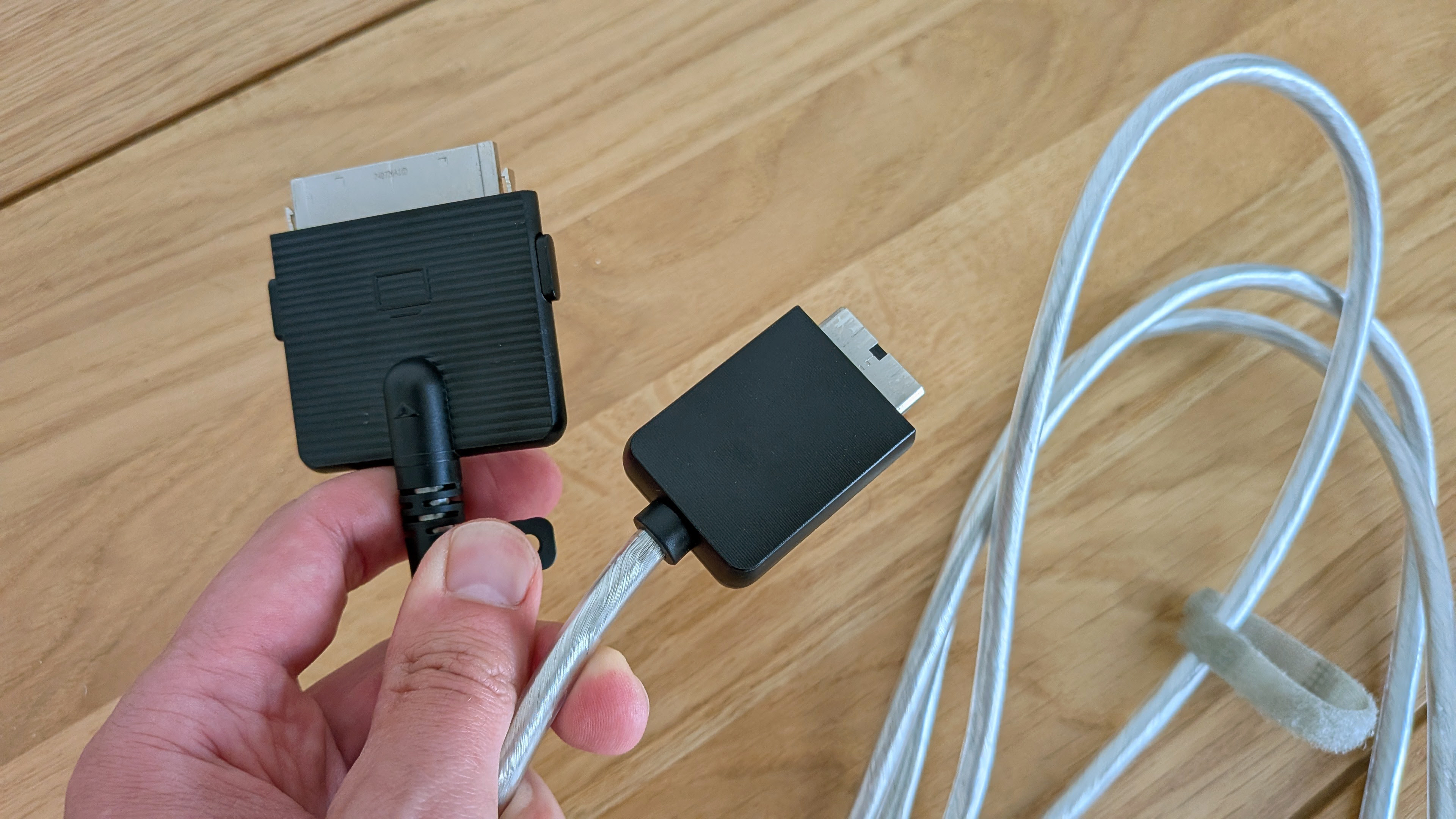
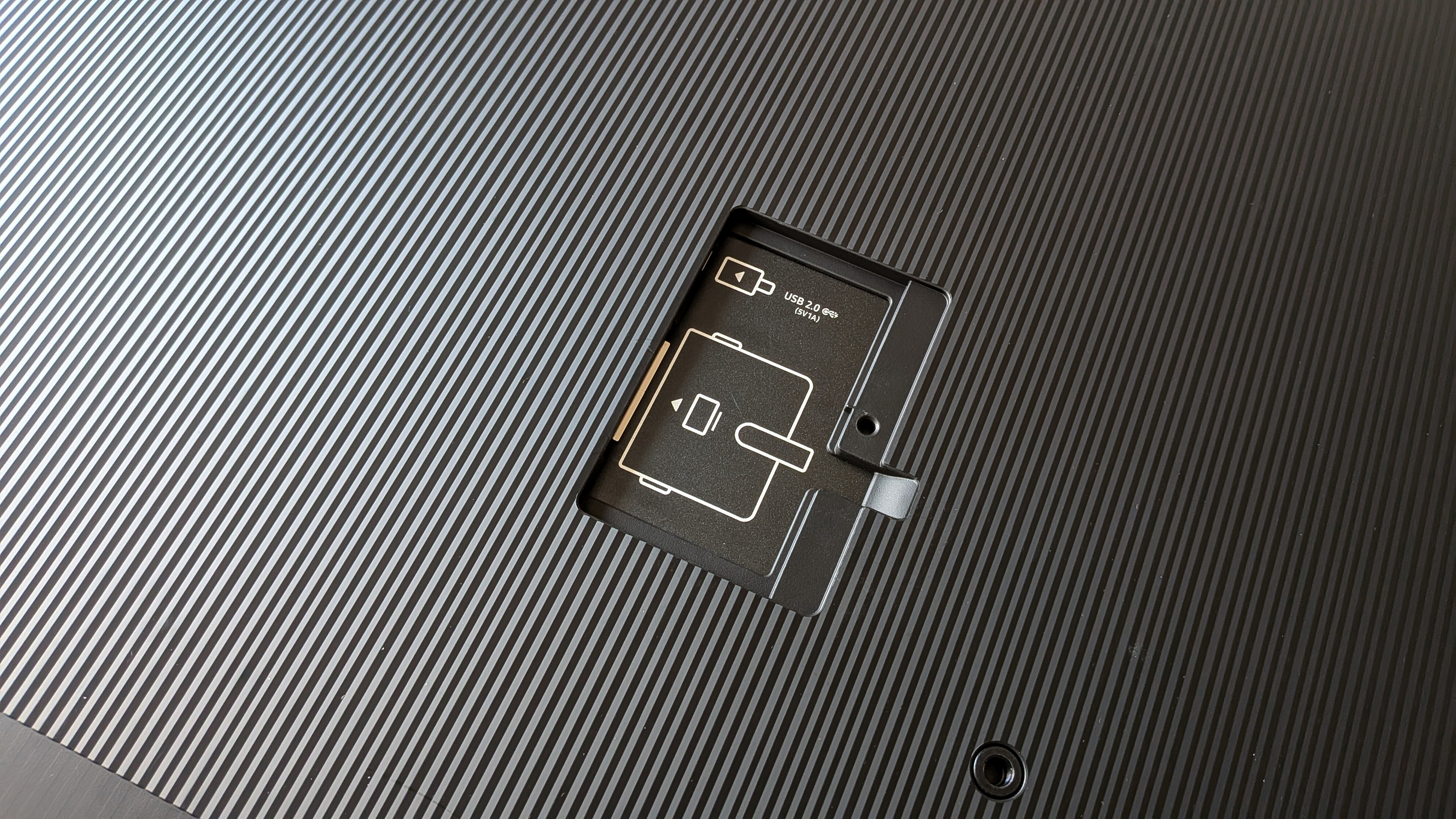
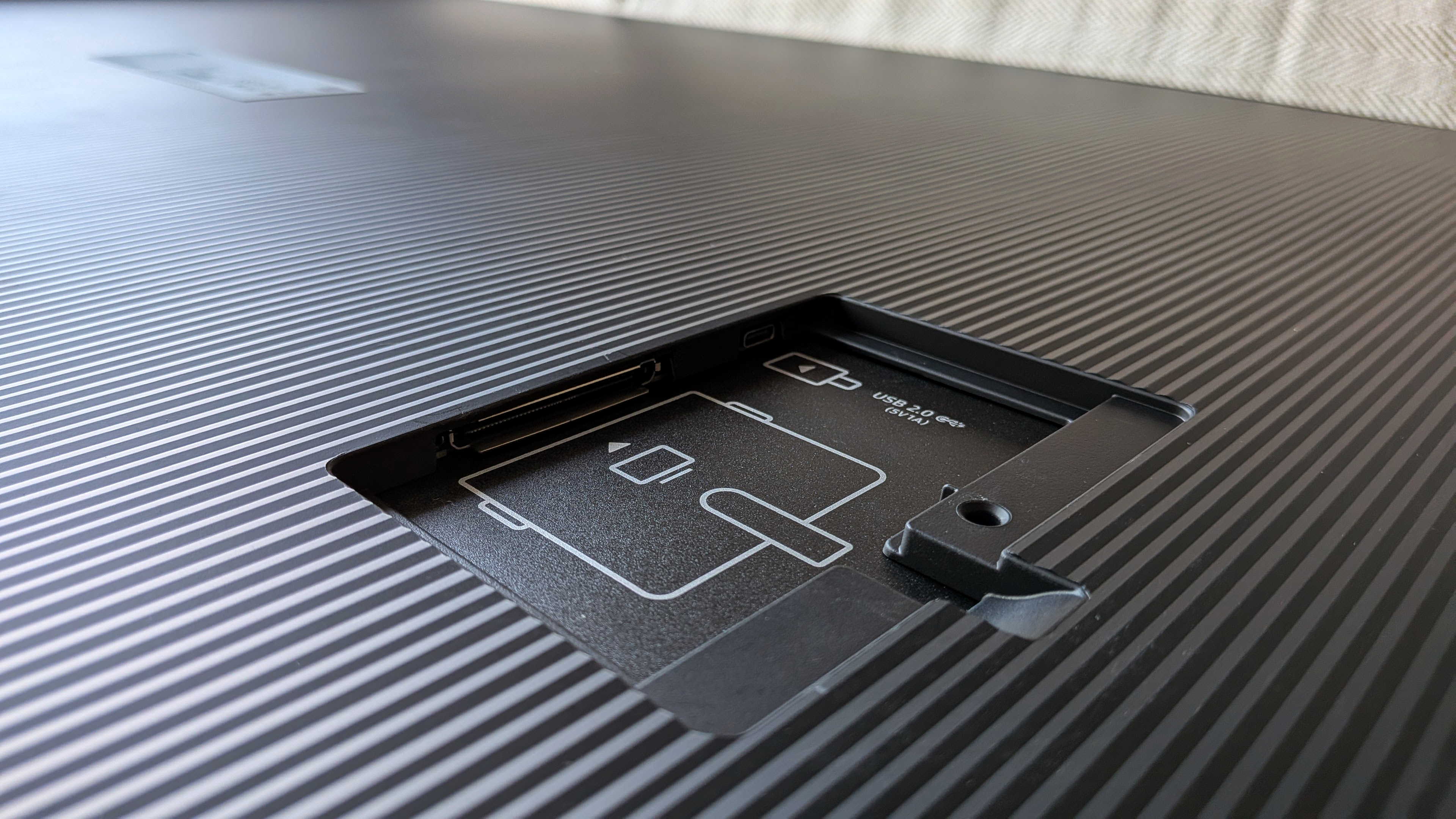
Visually, the S95F isn't exactly different to its S95D predecessor. But this is a TV, so it's not like anyone was expecting a full reinvention. Besides, Samsung's so-called Infinity One design looks great – signifying the near bezel-free panel that almost appears to be 'floating' within its housing.
The actual panel is the key difference for the 2025 flagship, though, with a brighter QD-OLED type, plus an upgraded anti-glare coating that not only does a better job – I've seen the two side-by-side elsewhere – but doesn't affect the picture output, so black levels and contrast is of a true OLED standard.
Powering everything is a new processor – the delightfully named NQ4 AI Gen 3 – which packs double the power of its predecessor, meaning greater upscaling abilities and automated AI adjustments, if you choose them. Samsung's Vision AI is new for this year, leveraging that processor.
How good is the Samsung's smart OS?
- One UI Tizen operating system
- 7-years of over-the-air updates
- Integrated Samsung TV+
- SmartThings integration
- Bixby voice assist
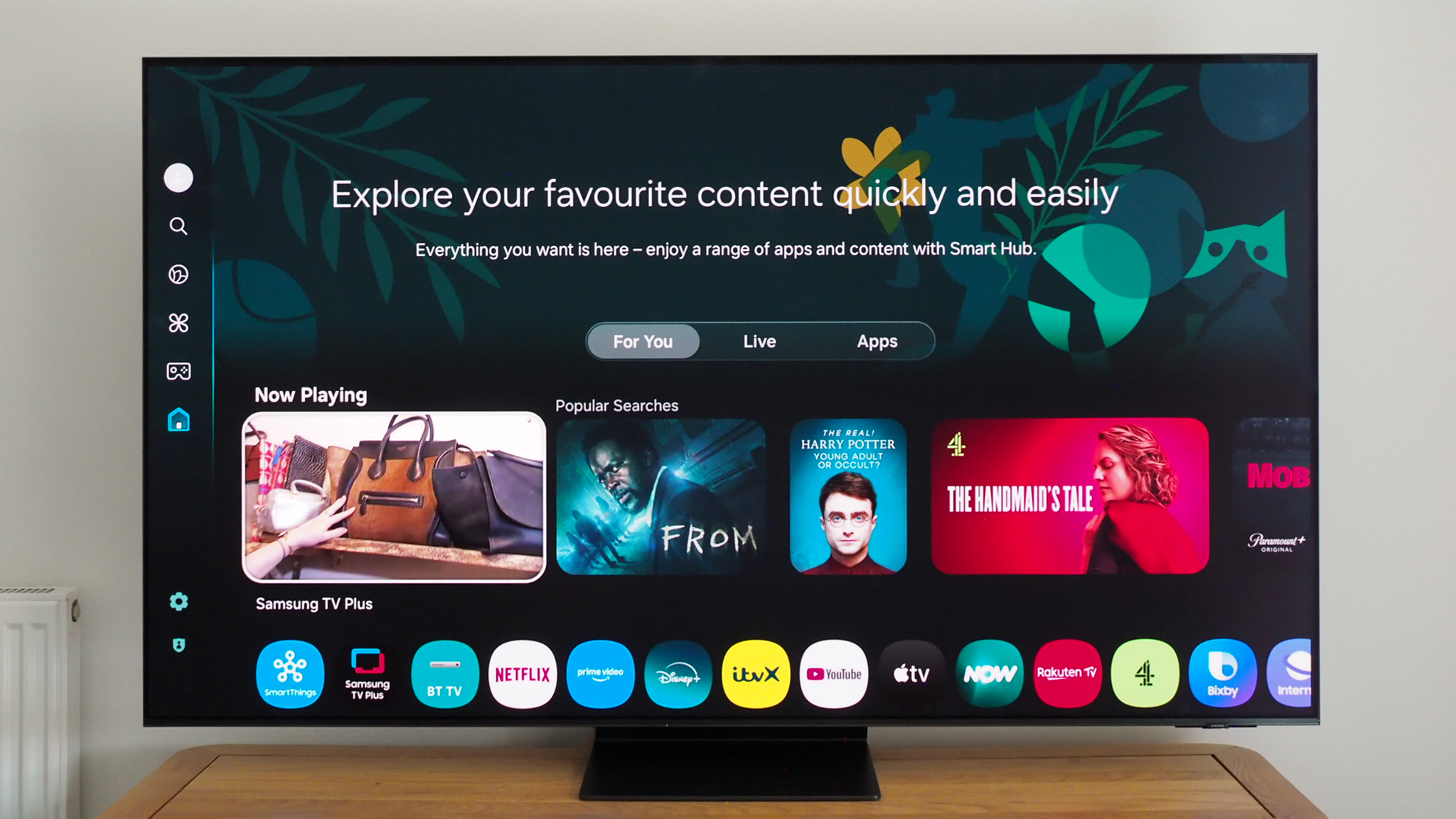
With all my sources plugged into the One Connect Box – EE TV 4K, PlayStation 5, an on-test soundbar via HDMI 3's eARC, and a Nintendo Switch OLED (not long for the Switch 2, mind!) – and the smart setup process swiftly handled via my phone, Samsung's One UI Tizen defaults the homescreen.
Here you can access a whole variety of things: your sources, integrated Samsung TV+ channels (there's no Freeview Play here), app shortcuts, or the various side-aligned options that offer Game, Daily+, Ambient, Search, and Settings.
All recent TVs I've tested seem to be obsessed with giant headers eating up a ton of space and pushing content previews and app shortcuts down the page. It's the same here, but at least Samsung hasn't jumped onto the advert bandwagon to serve up unwanted content front and centre.
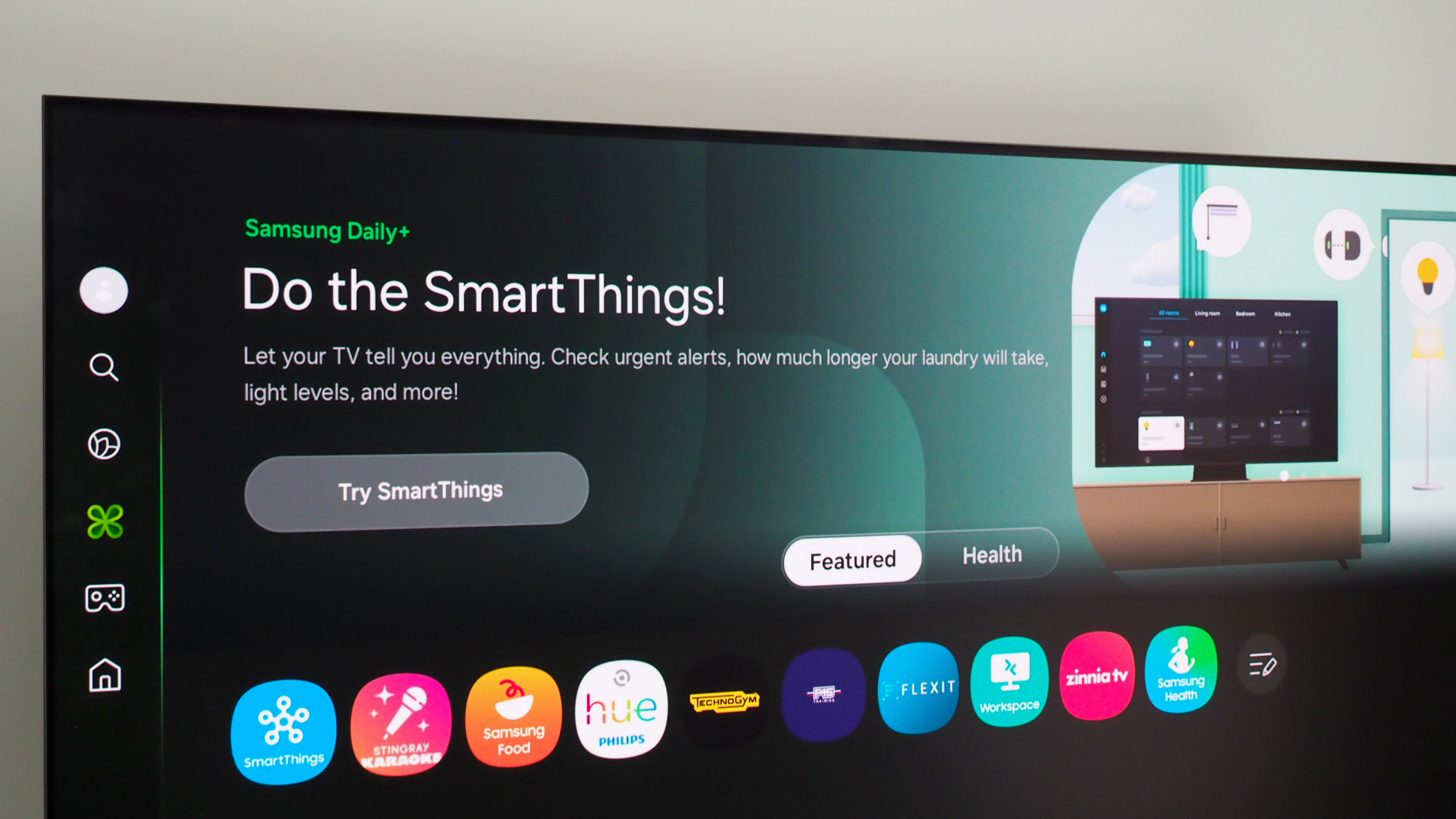
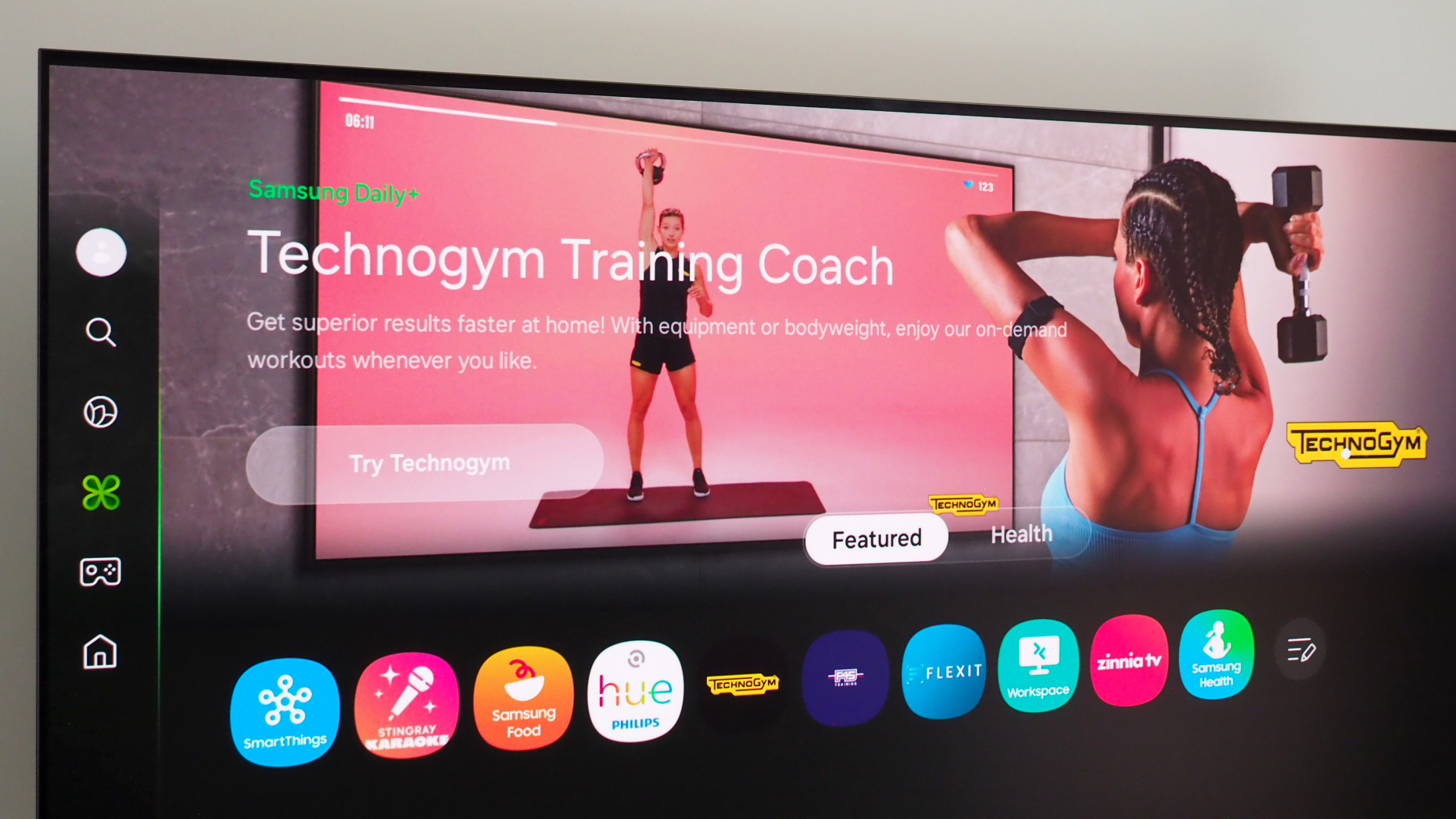
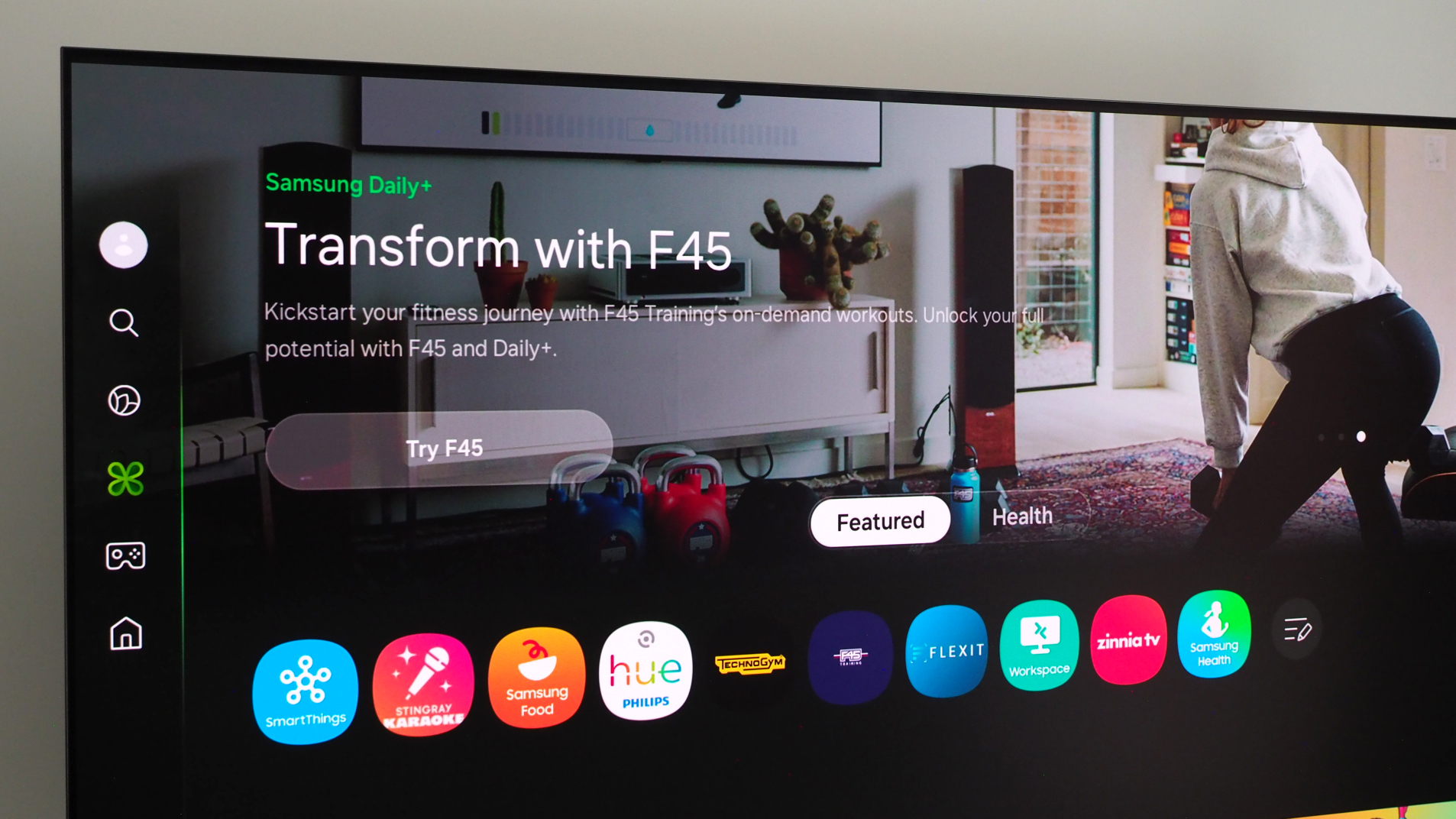
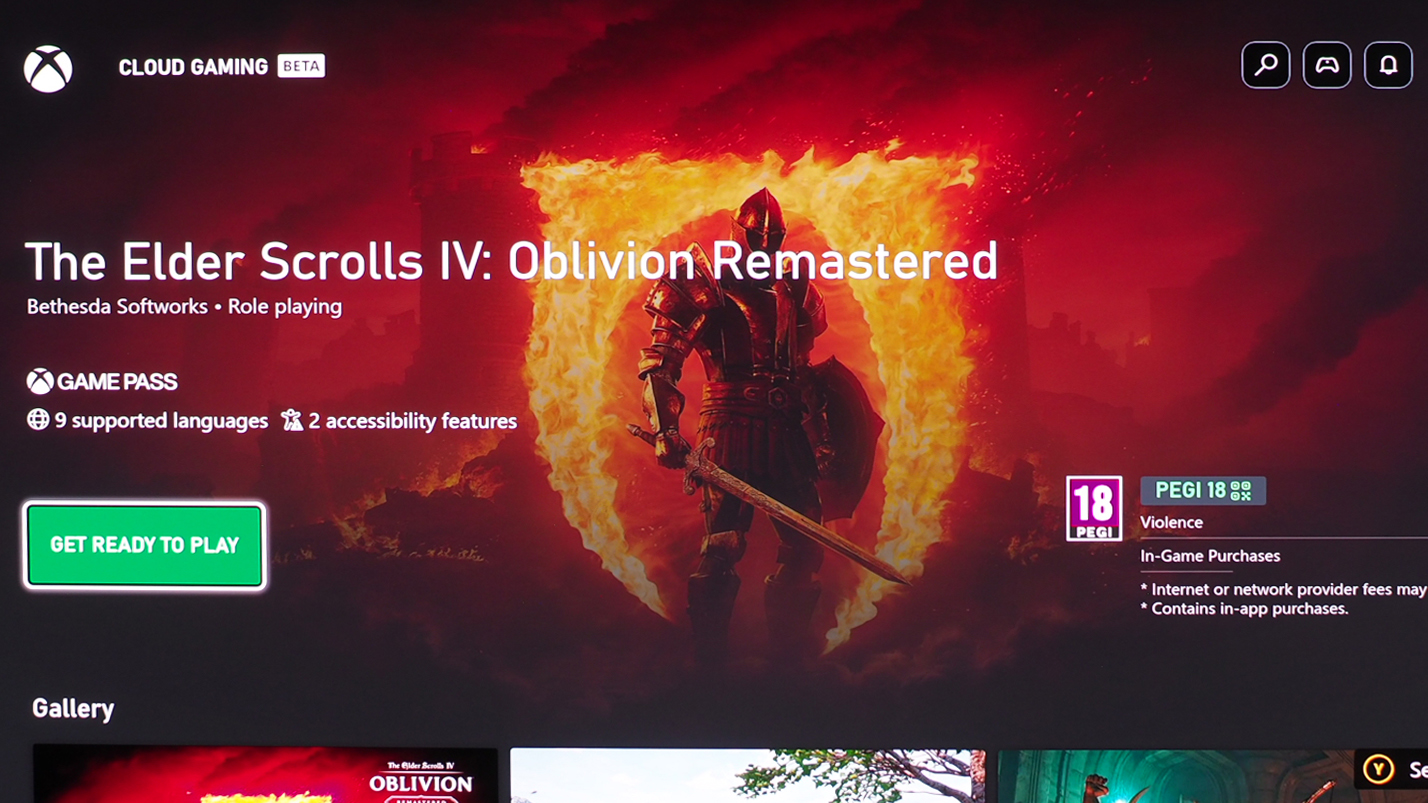
How deep you go with this system is up to you, really. The Ambient section allows for an always-alert display, offering animations, wallpaper, news feeds, and activation when you're in proximity, for example. Game can plug into Xbox, allowing play with no console required – although it's just not the same quality, in my view.
SmartThings, meanwhile, offers the ability to make your TV the hub of the home. You can connect accounts here, control smart home devices, even dig into some fitness training via Technogym/F45 Training/FlexIt. It's certainly a versatile system that pushes the idea of a smart TV to its smartest levels. However, so many options can get a bit cluttered.
That two remote controls are included seems somewhat confusing to me, too. The larger one inevitably offers more buttons and control, but the smaller handset is the more convenient and comfortable. It's here you can fire up Bixby voice control, which hasn't wanted to work for me at all, but I wouldn't want to use it anyway.
Does the Samsung S95F have the best picture quality?
- Infinity One design – only 11mm thick (excluding stand)
- OLED HDR Pro: HDR10+, HDR10, HLG
- Brightest ever QD-OLED panel
- 4K AI Upscaling Pro
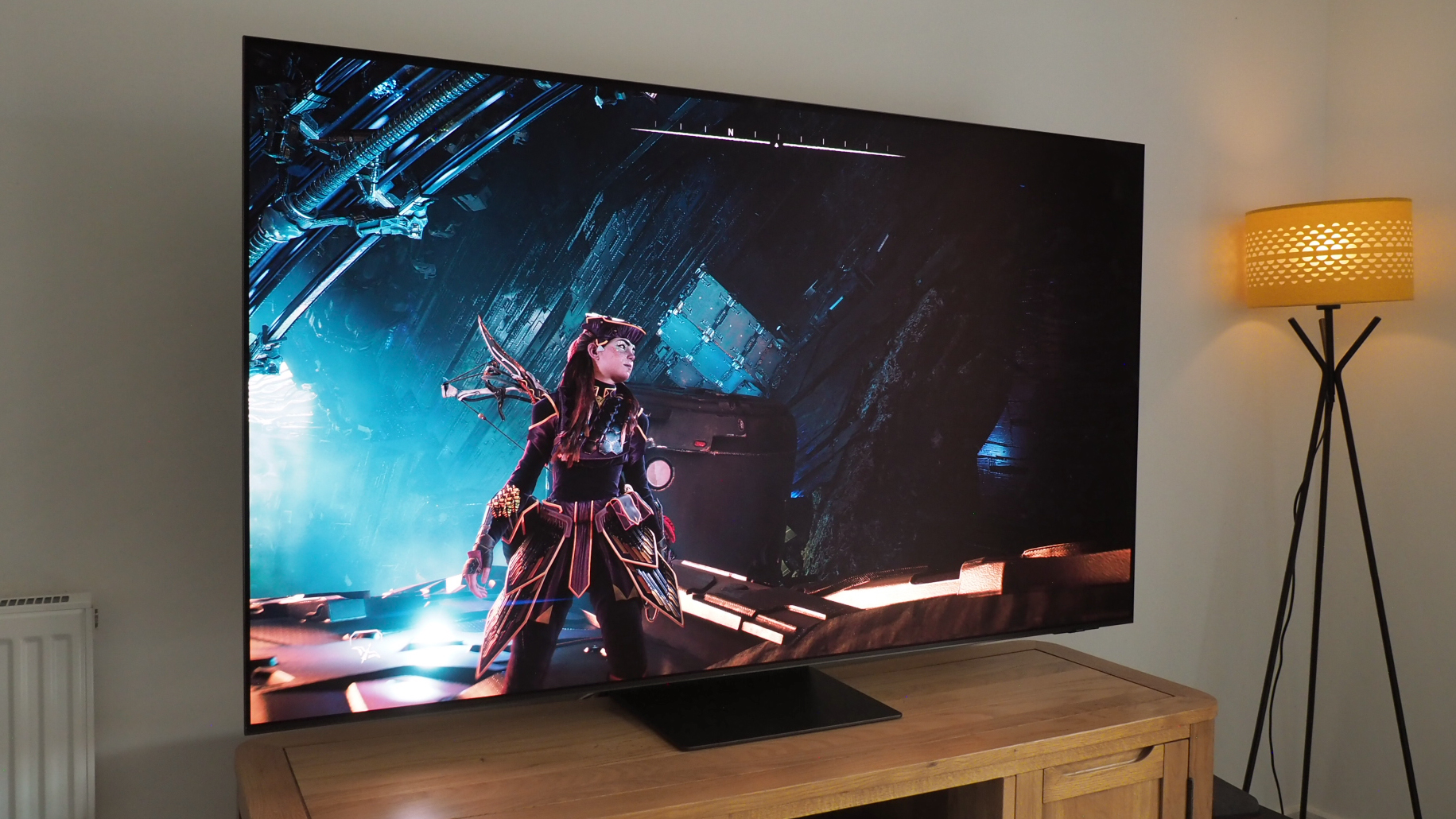
The real joy with the Samsung S95F is in its picture quality. It's immediately obvious just how capable this TV is, with almost searing brightness levels that truly surprised me the first time I switched the set on. Even in Standard mode, brightness exceeding 4000 nits is unheard of for an OLED TV type – yet here we are, witnessing it for real.
Not that the S95F has to be bright, mind, just noting that it can be. This sort of ceiling capacity looks absolutely sublime in Game Mode, where I've been playing Horizon: Forbidden West, or my go-to animation for TV testing, Spider-Man: Into the Spider-Verse (which even looks amazing in Dynamic, the preset that I'd typically avoid for, er, anything).
Not that you'll want the best streaming services or your favourite movies from higher-quality sources to be handled by such presets, which is where the S95F shows its greatness in control. Sure, it can be super-bright, but it can also be delicate. And that really matters where shadow control in filmic content is concerned.
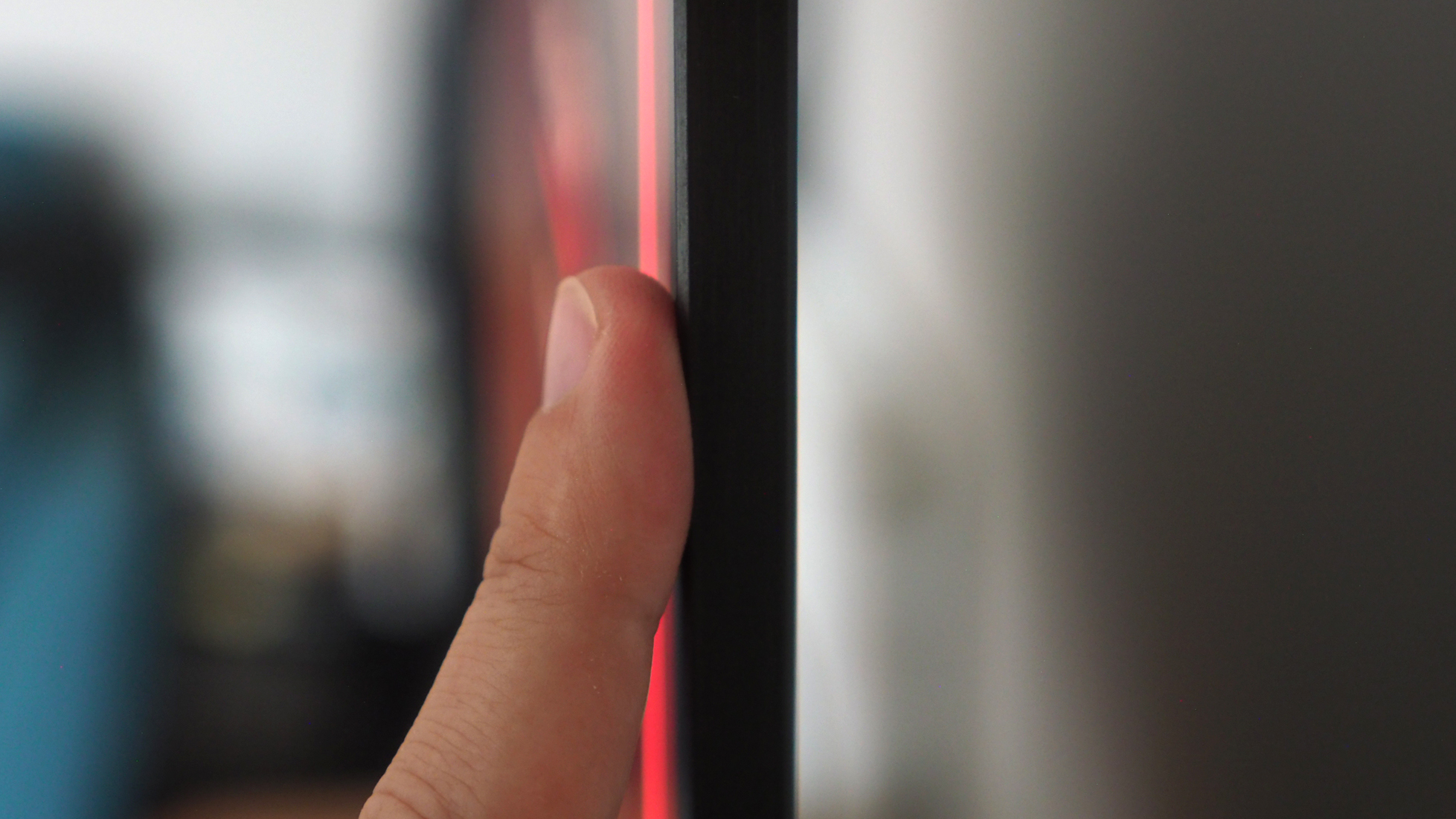
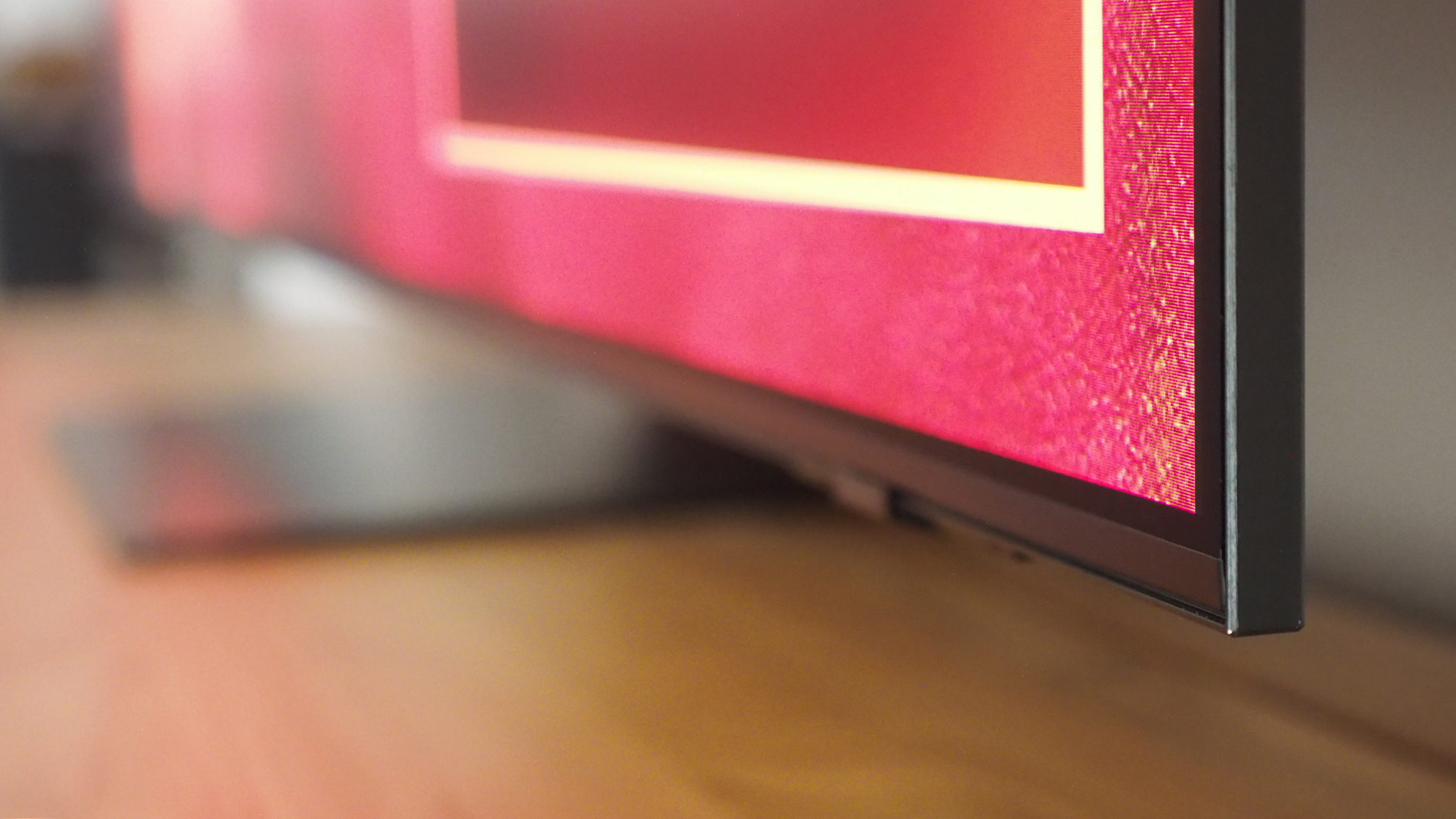
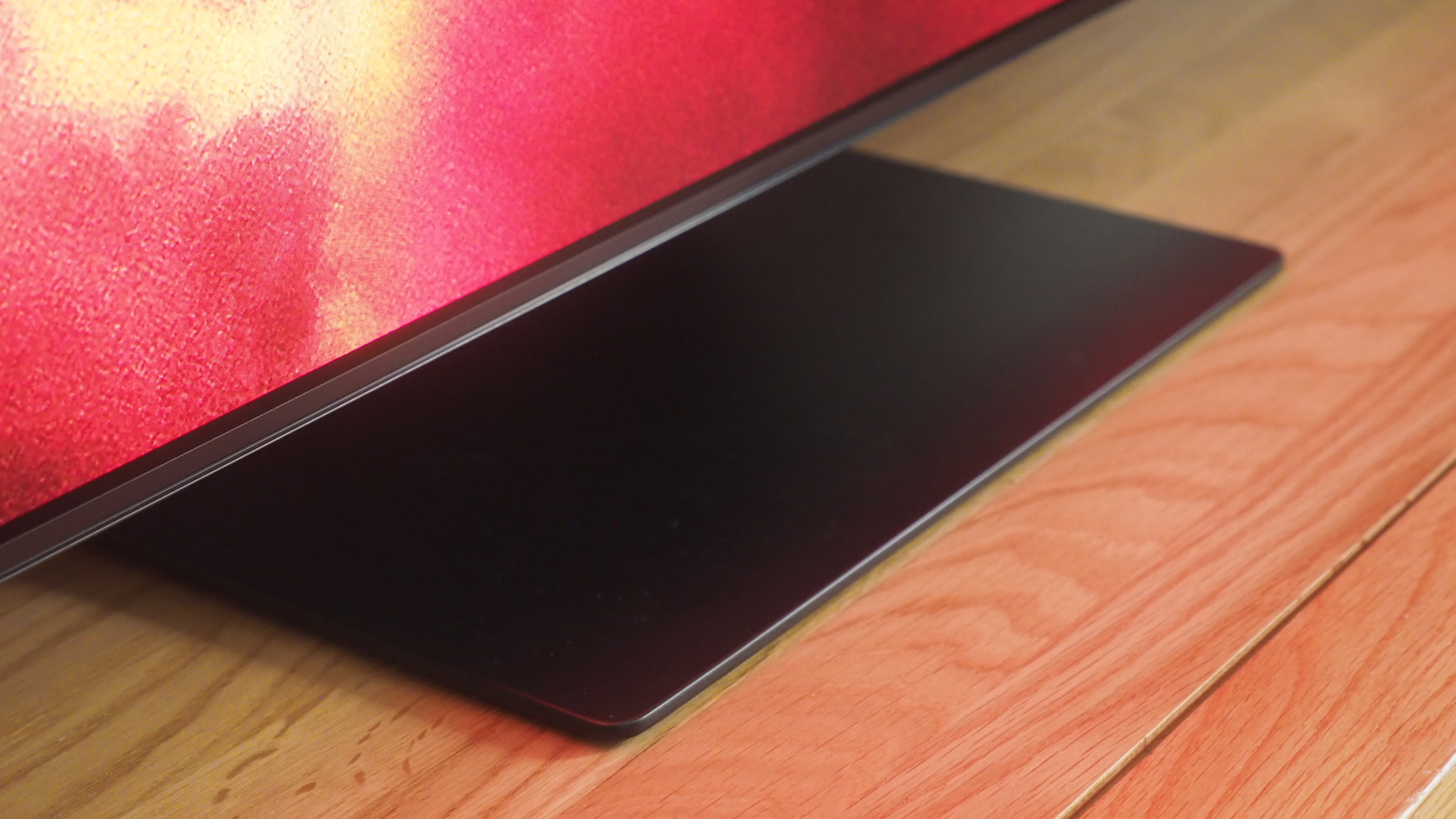
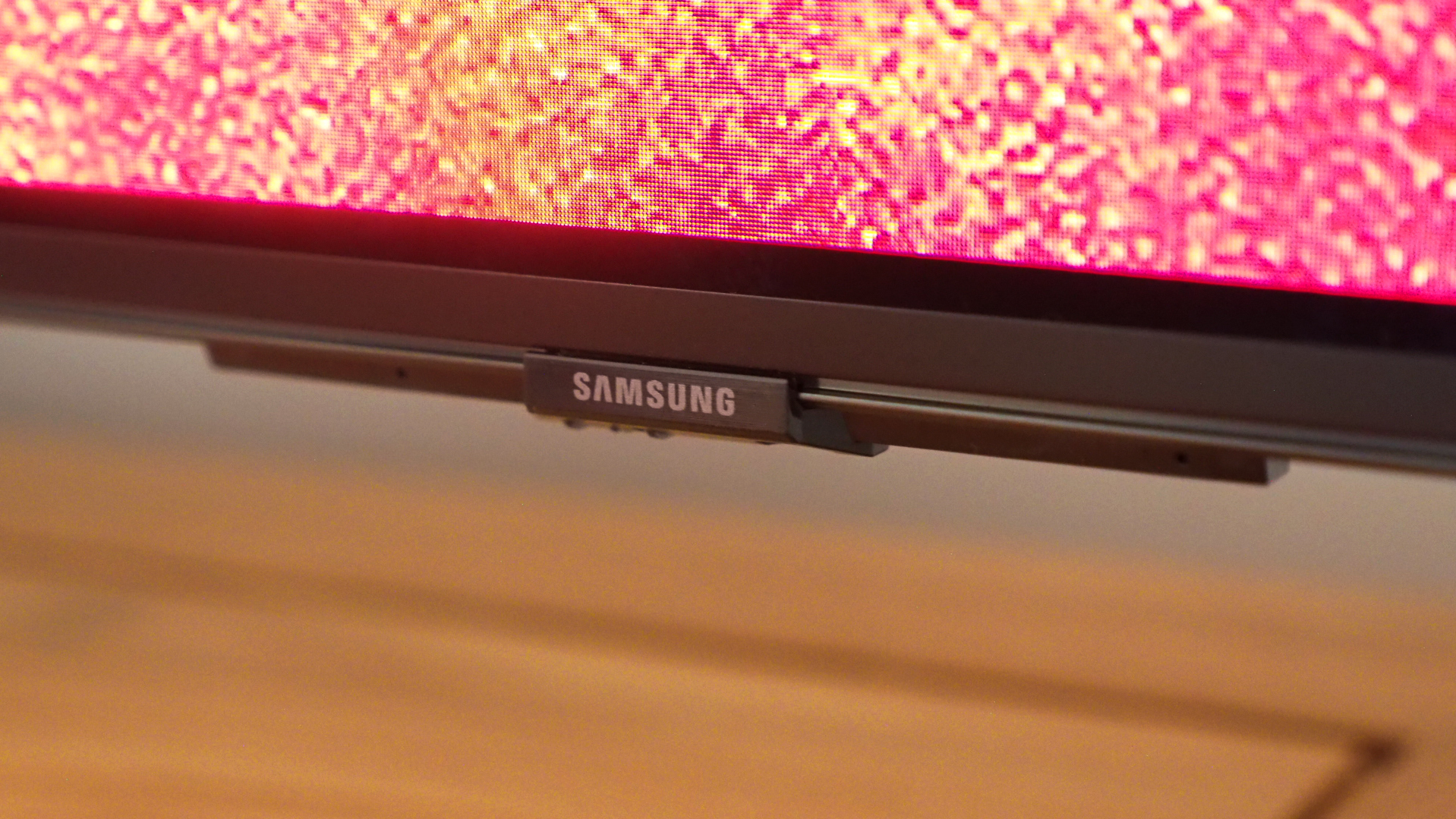
There are Movie and Filmmaker Modes easily accessible, which, as any home-cinema fanatic will know, a 4K Blu-ray source is the truest way to test. I made a movie night of Oppenheimer, and while it's not the brightest master for high dynamic range (HDR), the S95F does a grand job in portraying contrast and black-level subtlety from this source.
Setting up the source showed off just how considerable the S95F's output is. When prompted to adjust the floor and ceiling levels for the PlayStation 5, I've never had a TV where I've had to adjust those settings to almost the maximum. It means the steps between black levels are so nuanced it creates this perfectly subtle, smoothly gradated image.
Can the S95F get overexcited? Yes, of course it can. As can any flagship TV of today. Having such a wide range at its fingertips can be a wonder, but if you opt for the AI Mode – quickly selectable from the pop-up Settings menu – this can be a little heavy-handed with some sources. Not everything, though, and it certainly makes do of the S95F's considerable brightness opportunity.
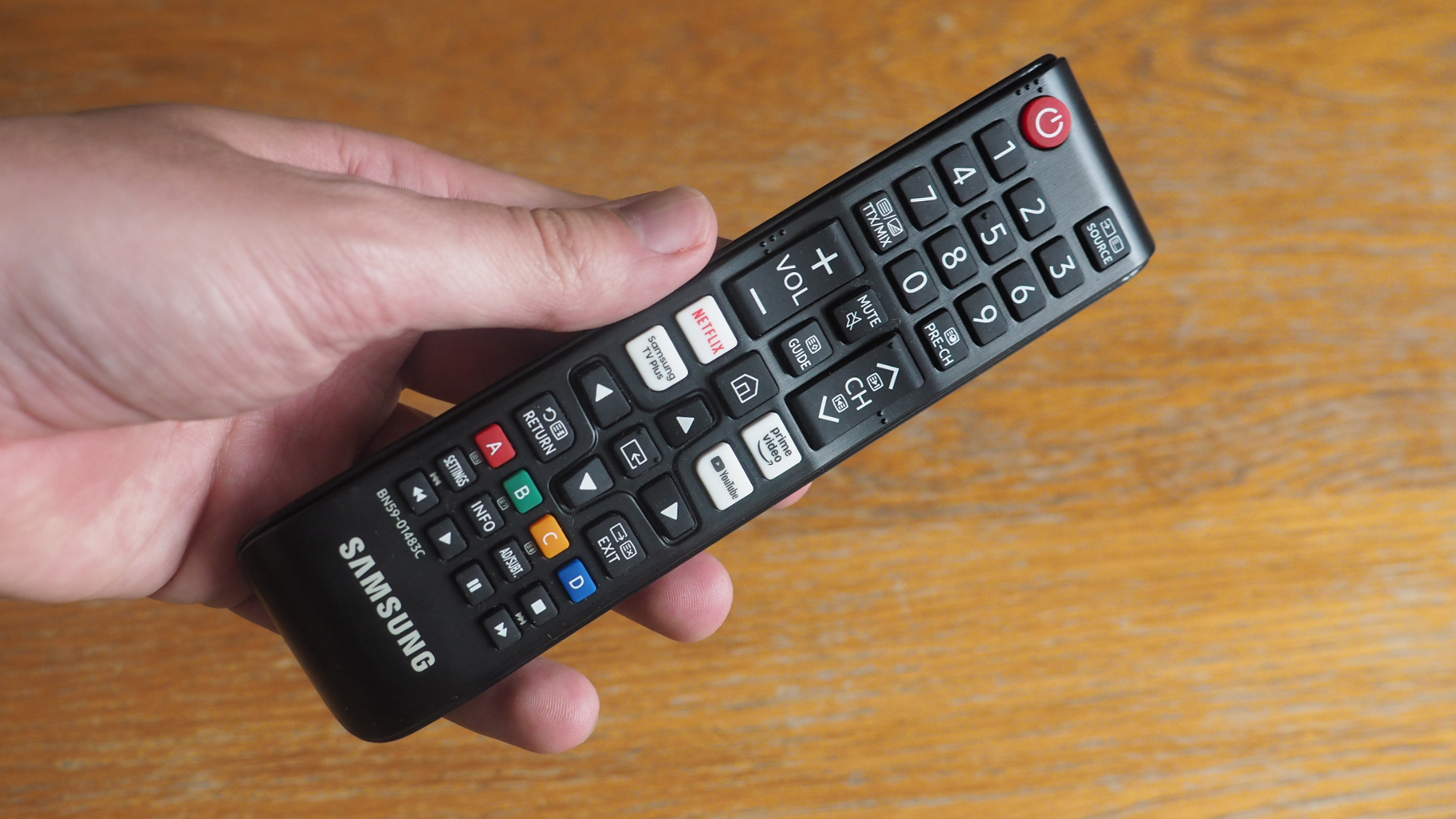
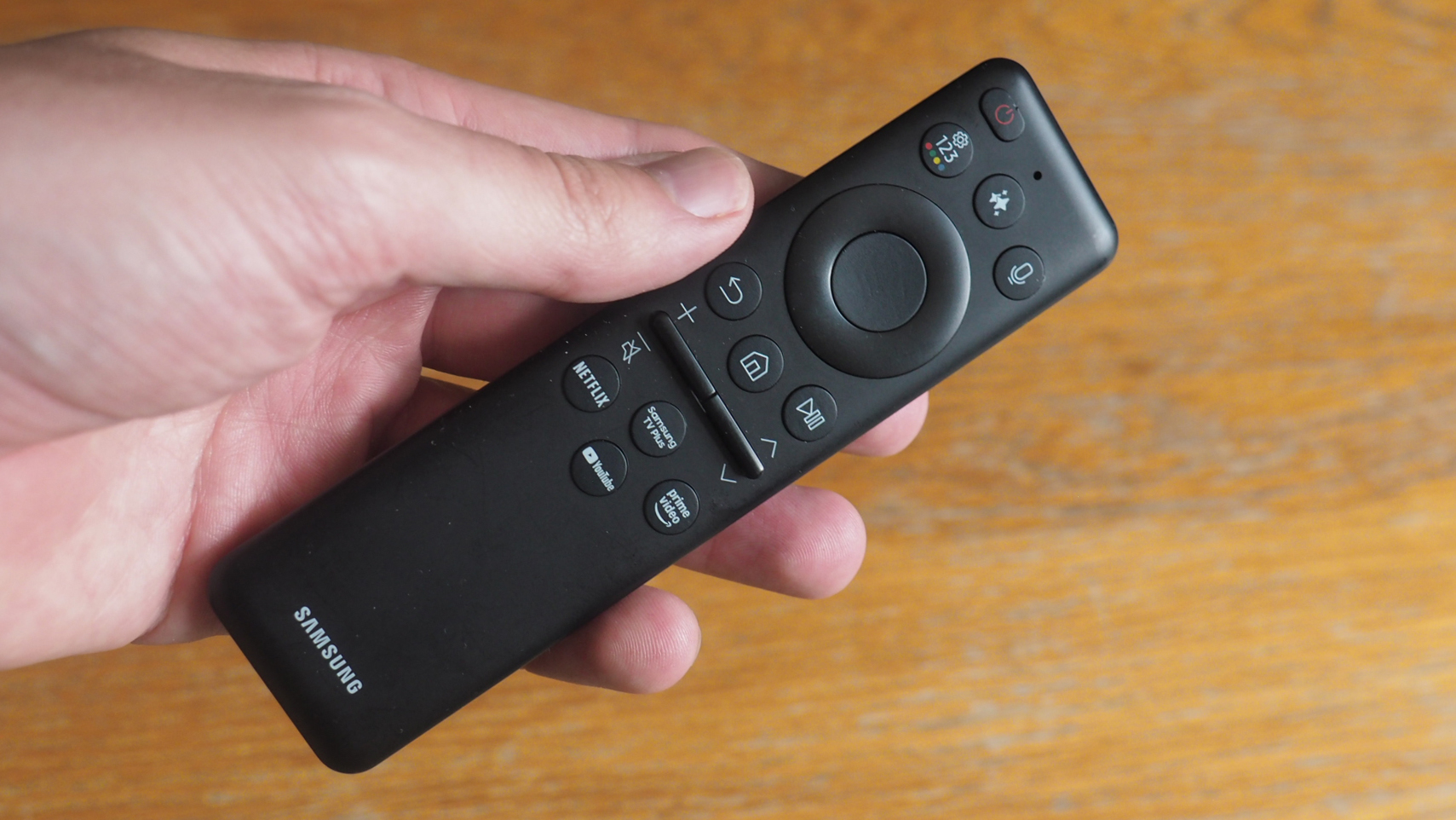
For those who want to customise there are ample options to tinker with. Some are simple, such as a two-level contrast enhancer to toggle between, while others in the Expert Settings panel can be slider-adjusted to control Brightness, Contrast, Sharpness, Colour and Tint. Some of these may be locked out if the Game or AI modes are active, however, and then there are various hoops to jump through to unlock these.
Any major problems to report? Well, Samsung being Samsung, there's no Dolby Vision HDR format compatibility here. Seeing as that's the most used, the reasoning is very clearly that Samsung's own HDR10+ type is the format it wishes to support – and a very good job this does.
Also of note is that the anti-glare screen can cause blacks to appear more grey if very bright light sources shine onto it, but I'm talking studio spotlight levels of bright. And, let's face it, nobody is going to do that. Compared to its more reflective-panelled competitors, however, the S95F is going to handle lamps, windows and more common daytime light sources impeccably well.
How does the S95F sound?
- 4.2.2 channel integrated sound system
- Object Tracking Sound+ immersive surround
- Q-symphony compatible (with Samsung soundbar)
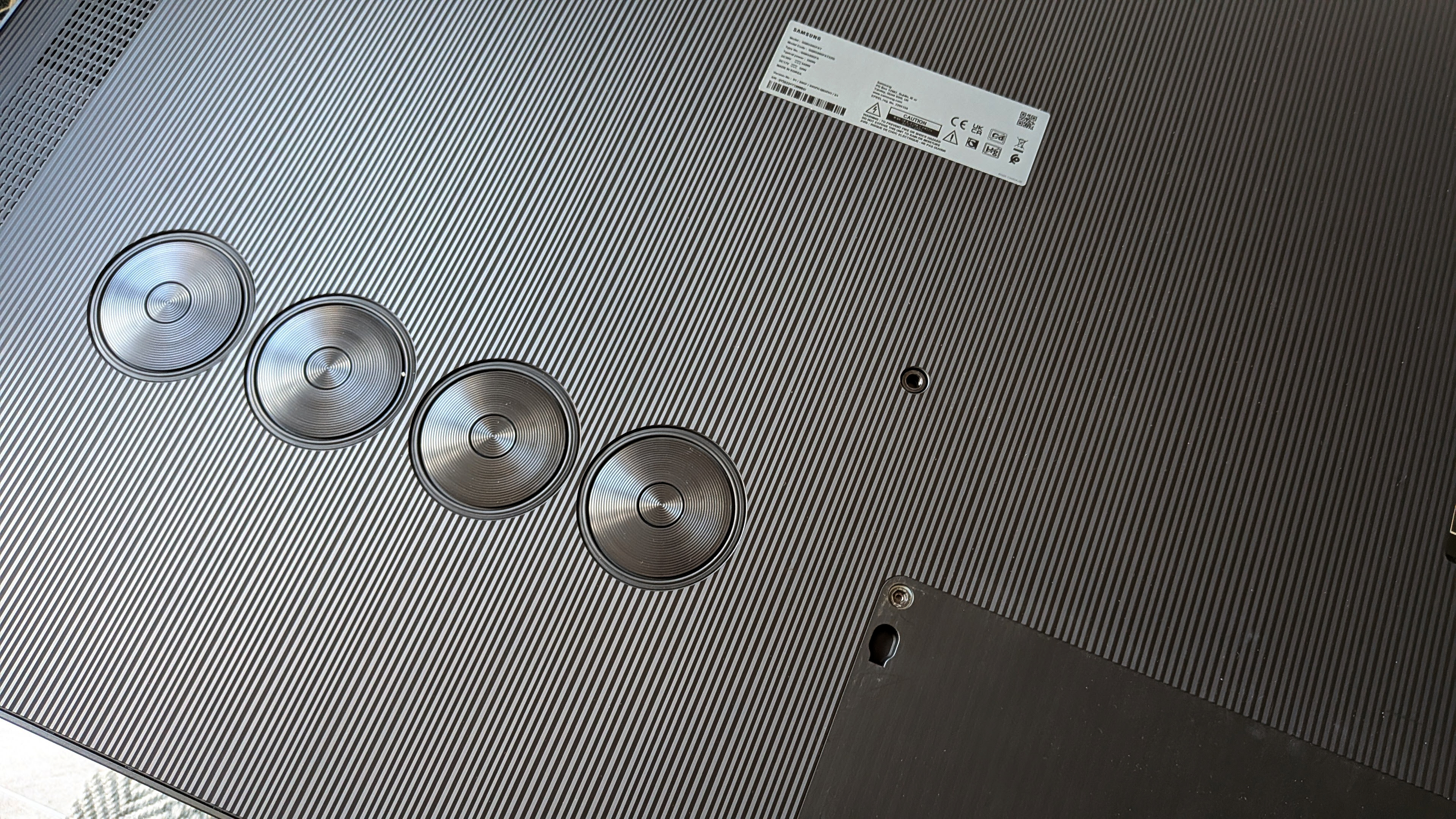
Given that the S95F is so thin, I'd more or less written off the chances of it sounding any good from the start. But how wrong I was to assume that, as this set does a stellar job with the space it's been assigned to deliver decent audio straight out of the box.
The integrated sound system is a 4.2.2 arrangement, meaning four channels for the front and sides, two for bass, and two for overhead. While there's no Dolby Vision, Samsung does support Dolby Atmos, meaning the processing can give a pseudo three-dimensional output that's pretty effective. The left-right separation of those four-per-side speakers (as pictured) helps with this.
This is also where that processor comes into play, as Samsung's OTS+, or Object Tracking Sound Plus, is designed to make the sound more convincingly emerge from its position related to the on-screen image. I find the height from the panel accomplished, to the point that you wouldn't outright need one of the best soundbars to sure things up.
However, here's where the S95F, like the brand's other flagship tellies, gets even more intelligent. Buy one of the best soundbars for Samsung TVs – by which I mean a Samsung model, such as the Q990F – and the Q-Symphony feature means all the soundbar's channel outputs plus the TV's system can be used in concert. I've heard this before, although not at home for this particular review, and was blown away by how truly immersive the experience becomes.
Samsung S95F review: Verdict

I was expecting the Samsung S95F to be a decent TV, but it has surpassed all my expectations. If you're willing to pay for best-of-best and want a gaming and home-cinema powerhouse, then look no further.
The S95F delivers pure class for movie-lovers, thanks to picture modes that rival classic OLED with great nuance to their black levels, even in deep-contrast scenes. Let that brightness potential loose, however, and for gaming and other suitable content, the punch from its images has major clout.
Sure, the AI mode can be a bit heavy-handed, the mass of One UI cards and two remote controls feels a bit cluttered, there's no Dolby Vision HDR, and the anti-glare panel can be fooled if you're shining very bright lights at it (which, frankly, you won't be).
Now that I've lived with the Samsung for a week as my own, and having reviewed many of the best OLED TVs in 2025 already, the S95F has proven to me that it's the perfect blend of design elegance, deft picture control, and admirable sound output. It's an untouchable all-rounder.
Also consider
If you can find last year's S95D on discount, then it's still an admirable offering – with a slightly less effective anti-glare panel – that, for the right discount, would be a savvy buy.
For pure OLED fans, however, the LG OLED G5 would be my other strong recommendation, rivalling the Samsung in almost every way – without quite the same brightness peak and much worse integrated sound.
Or, for a fully all-in-one solution, last year's Panasonic Z95A has a stonking 360-degree sound system and impressive MLA OLED panel that still more than stands up. Again, for the right price, it's home-cinema perfection.

Mike is T3's Tech Editor. He's been writing about consumer technology for 15 years and his beat covers phones – of which he's seen hundreds of handsets over the years – laptops, gaming, TV & audio, and more. There's little consumer tech he's not had a hand at trying, and with extensive commissioning and editing experience, he knows the industry inside out. As the former Reviews Editor at Pocket-lint for 10 years where he furthered his knowledge and expertise, whilst writing about literally thousands of products, he's also provided work for publications such as Wired, The Guardian, Metro, and more.
You must confirm your public display name before commenting
Please logout and then login again, you will then be prompted to enter your display name.
